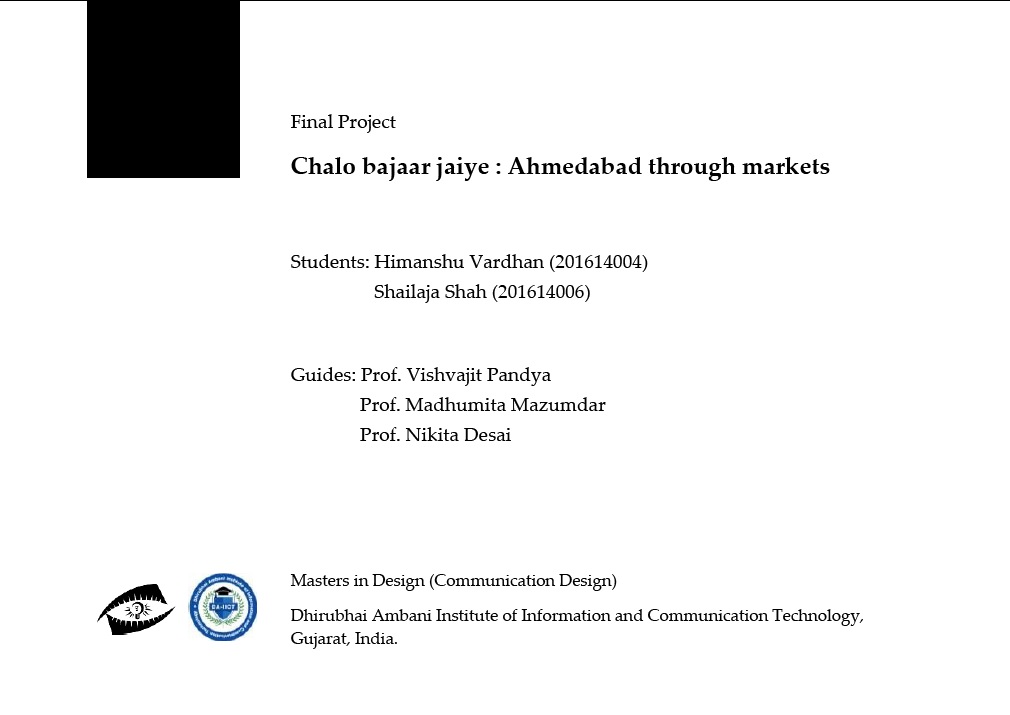Chalo bajaar jaiye : Ahmedabad through markets
Abstract
The idea of this project was to bring awareness among the tourists who are going to visit the city or the migrants who are going to shift to the city or the locals about a historic city Ahmedabad through a different dimension – the city’s old vibrant markets. During the process of literature review we figured that there were many books written on the historic city Ahmedabad which largely focused on the heritage monuments of the city. After Ahmedabad was declared as World Heritage City in July, 2017 the city’s heritage added much more value to its existence. However, according to the official documents submitted for the nomination of World Heritage City at UNESCO, Ahmedabad has been given this title primarily for its tangible heritage which includes physical artifacts and monuments of the city. But throughout the history of 600 years of the city, there have been certain cultural values and social practices which have been inherited through generations and are nothing but intangible cultural heritage of Ahmedabad. Through initial research we understood that apart from the monuments, there are some old markets of the city having certain social practices and cultural values associated with them which could at large provide a meaning to the existence of the city. Since those old markets of Ahmedabad were then built and developed around a group of people following certain ethnicities or religions or languages and gradually created an environment of people following certain cultural values and performing certain social practices these markets are full of diversities of people, commodities, traditions, languages and communities. Hence, for anyone who wishes to know Ahmedabad and its history, there should a way other than the tangible heritage information which allows him/her to know this different aspect of the city. Thus, to fill in the gap of introducing the city in various ways we came up with a solution to tell a story of the city through different perspective – through its old markets. In order to do so it was important to first understand the different attributes associated to the markets situated in the eastern part of the city Ahmedabad – old Ahmedabad as historically the city was only developed on the eastern side of the River Sabarmati; it was the time during the rule of British Crown when Ahmedabad got expanded on the west too. To known the markets in depth field visits were carried out, which brought out different aspects associated with markets like their histories, commodities, type of selling involved in different markets, types of buyers, market timings, peak hours etc. Since the target audience of our product could be either an outsider or an insider, it was important to have multiple narratives which could help them know the markets and further the city in their own ways. To achieve this, we categorised and prioritised the set of data about each market gathered from the field. The primary classification depending on the targeted audience was done based on their establishment years, commodities, locations of the markets and the types of selling (wholesale / retail / wholesale and retail both) involved in a particular market. In order to tell this story in the best possible way a medium had to be chosen which be the most feasible for such a set of information. Hence, we decided not to move ahead with the idea of designing a book as it becomes very linear for the user to read the information in such a static format. To make the information interactive and easily accessible to maximum number of users in the world, we figured that a website would be the most suitable medium to design this information. The designed product works as an informational website which generates a virtual experience of markets among the users through sounds, visuals and textual content. This website is meant to allow the user to look out for information according to his/her need. The multiple narratives structured to tell the story in different ways are: a) Through the locations of the markets in the city along with the year when they were established at those locations b) Through the categorised set of commodities sold in those markets c) Through the information on nearby markets which could be visited in a day This website can further be developed in mobile view and tablet view which would make it even easier to access for the users from anywhere on the field.
Collections
- M Des Project Reports [107]

